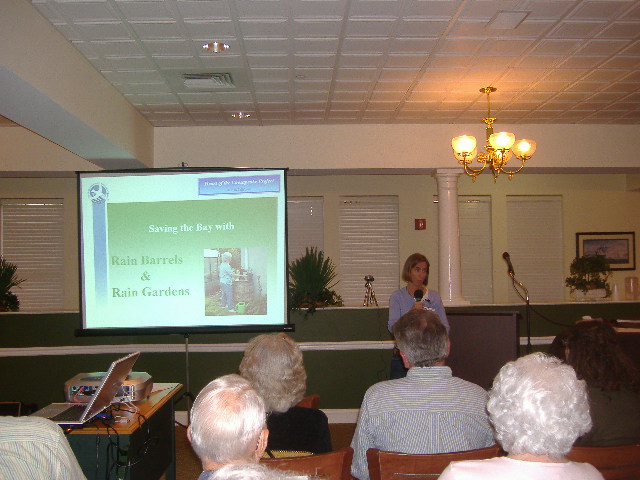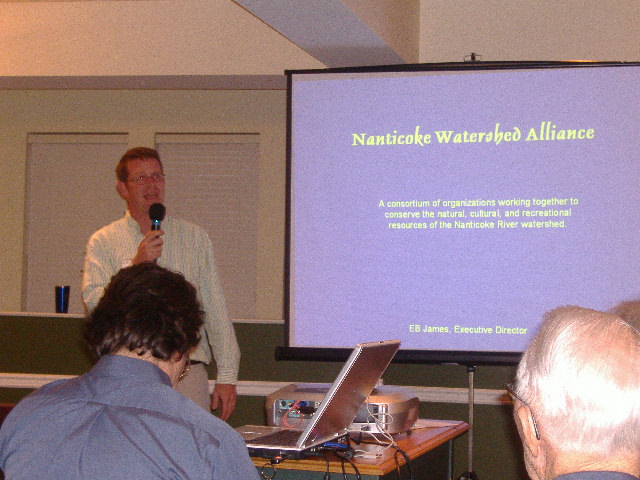People may be shocked at me, I actually skipped a Shorebirds game to attend the meeting. Even Rick Pollitt mentioned that when we spoke briefly afterward. And when I saw a table like this, I thought I’d need to be loaded for bear:

Surprisingly, it wasn’t all that bad of a meeting, or at least they brought down the level of radicalism to something tolerable. After some welcoming remarks by Orphans Court Judge Bill Smith, who is a resident of the Mallard Landing development where the meeting was held, and Rick Pollitt speaking briefly about the “successful first year” of the Wicomico Neighborhood Congress, Jim Ireton came on to introduce the evening’s first of three speakers.

As outreach and media relations director for the local Heart of the Chesapeake branch of the Chesapeake Bay Foundation, Margaret Vivian went through some of the “challenges” facing the Wicomico River basin and took a quick look at results of the Creekwatchers’ 2007 water quality survey. I will give the Creekwatchers credit for being pretty thorough as they take samples and check site conditions from 26 locations in the watershed on a regular basis.
Obviously their concern was water quality, and the “biggest culprit” she named for the dismal results of the 2007 Creekwatchers Wicomico watershed survey was the amount of nitrogen getting into the water, mostly from waste products and fertilizer (to some farmers and gardeners, those are one and the same.) But with 16 million people living in the Chesapeake Bay watershed, development in general was not spared blame. Vivian pointed out that, despite the fact that 2007 was a dry year with rainfall well below normal, the water improvement that can be expected in those conditions didn’t materialize. This anamoly was theorized to occur because of human activity such as wastewater and runoff from paved areas. None of the factors they measured met the CBF’s quality standard, although it wasn’t made clear how these standards were determined.
Margaret explained that the excess nitrogen in the water led to algal blooms and “dead zones” which at one point affected 35% of Chesapeake Bay, mostly along the Western Shore. Locally some assistance in reducing the nitrogen number could be expected upon the completion of upgrades to Salisbury’s wastewater treatment plant, cutting the nitrogen from that source by over 2/3, to an estimated 103,000 pounds from 330,000 prior to improvements.
She also took a brief look at rain barrels and rain gardens, which are steps homeowners can take to improve water quality with the possible benefit of reusing graywater for irrigation or other non-potable uses. (This is a feature found on many LEED-certified buildings.) Vivian pointed out that the CBF offices in Annapolis saved 90% on their water bill by the installation of three large rain barrels on their roof. It’s a pity she didn’t stay around because I wanted to ask her what the payback period was for the installation when you factor in the extra structure required and other construction costs, while accounting for whatever power is saved in pumping because of the gravity feed. But when a 1″ rainstorm creates 600 gallons off a 1,000 square foot house (about the size of mine) you need a bunch of barrels!
Fortunately, she stayed pretty much within the purview of items that can be classified as “personal responsibility.” It’s something I’ll return to as I wrap this post up.

A much more brief presentation was made by E.J. James of the Nanticoke Watershed Alliance, which is an umbrella group of entities with interest in the river. Those run the gamut from business to environmental and also include several NGO’s like the Chesapeake Bay Foundation.
He focused mainly on their volunteers, which NWA notes have “transformed into citizen scientists”, who participate in their testing program in the field – or, in this case, in the creeks and streams that make up the Nanticoke’s wide watershed. While James said that the group only “moves with the guidance of its organizations”, I found it noteworthy that while its funding comes from both Maryland and Delaware, the “root” of the money is the federal EPA. The NWA is working on becoming a certified data collector for the EPA, and with its emphasis on equipment that can measure data in the field rather than needing to collect samples for a lab to evaluate, may have a leg up on that goal.
In response to a question from the audience (of the 60 or so there, a large part appeared to be Mallard Landing residents), James felt that the Nanticoke was the most “pristine” of the Chesapeake watersheds because it was among the least developed and had the added benefit of a large swath of marshland around its mouth. There was no major city along its banks so cleaning the river wasn’t looking like a “rear guard” action.

Our final speaker was David Curson, who serves as the Director of Bird Conservation for the National Audubon Society. Obviously his task is to save the birds native to our area from the twin endangerment risks caused by loss of habitat quantity (another way of saying suburban sprawl) and habitat quality (where larger swaths are subdivided into smaller ones and certain species who rely on deep forestation lose their ground.) By “prioritizing sites for conservation,” Curson hoped to identify a network of sites with sufficient habitat and focus on them. Possibly most important among the sites in this region are the salt marshes, where some species and subspecies unique to that type of area live.
I noticed that one large piece of assistance with regard to identifying sites was provided by the Maryland Department of Natural Resources, since they classify “green infrastructure areas” that closely relate to the “Important Bird Areas” the NAS identifies. In Wicomico County, much of the southeast corner of the county is in what’s known as the Pocomoke-Nassawango IBA, while the areas along Chesapeake Bay are called the Somerset-Wicomico Marshes IBA and a tiny bit in the northeast corner falls into the Cypress Swamp IBA. In all, there are 26 “Important Bird Areas” in Maryland and David placed the overall goal at around 40 when evaluations are finished in coming years. While being in an IBA places no legal restrictions on land use and is voluntary, Curson did take some time to speak out on Wicomico County’s practice of cluster zoning, calling it “harmful.”
Further in that vein, David remarked that, in general, “development is going on at an alarming rate” and that we needed to “keep new developments in town.” He even used a graphic from anti-growth zealot Eben Fodor to assist his argument, one that compares the cost per dwelling to the number of houses per acre. I will give him his due, though, since I asked him afterward where he lived and he indeed lives in an urban area rather than out in the suburbs like some of the NIMBY anti-growth folks around here do.
Unlike prior meetings of the WNC, there was no breaking up into sub-groups to discuss local problems and suggest solutions, and this is where the WNC is beginning to fall short of its goals in my opinion. Certainly it’s not a bad thing to have speakers who are experts in the field, but in my neighborhood the environmental concerns have more to do with drainage and the occasional leaky septic system, or the person who doesn’t take care of their lawn (maybe they were trying for their own rain garden – who knew?)
And while I applaud the groups who sent their representatives to speak to us showing relative restraint and making this more or less about individual responsibility, I know that many among the groups they represent have no objection to government running roughshod over private property rights. One recent example brought up at last night’s WCRC meeting by Delegate Elmore was the compromise that “only” extended development buffer zones to 200 feet instead of 300 feet – still, that’s twice as much land placed off limits because the law was originally set for a 100-foot buffer zone. The secret weapon of bigger, more intrusive government is incrementalism and if the radicals in groups like the CBF don’t get their way in a particular session they don’t seem to get the hint that maybe what they’re asking for is too much – they just lay low until a more friendly Governor or General Assembly is in place, or ask for just a little less the next time.
We’ll see if that trend toward picking speakers representing left-of-center organizations continues in the remaining two WNC meetings that have topics selected for this year – next up is housing (so look for an emphasis on affordable housing with the WNC’s Debbie Campbell influence) and later on will be senior issues.





